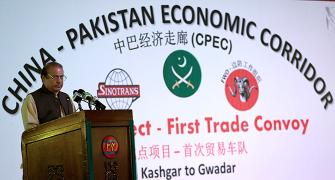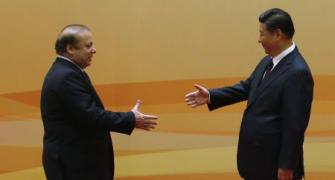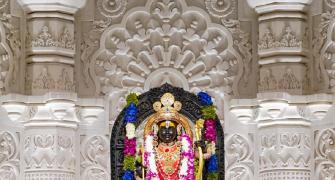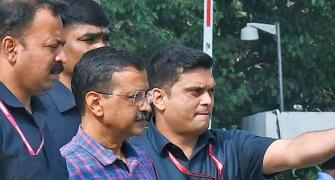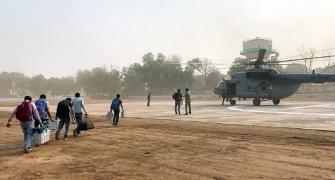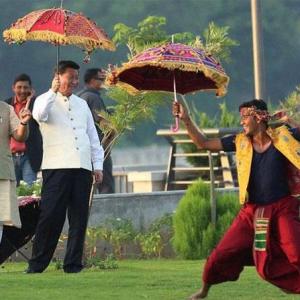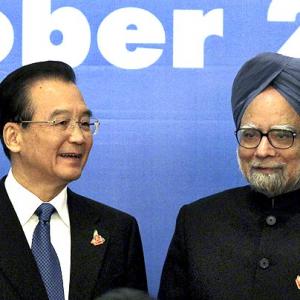'Xi Jinping got a dose of Modi's medicine inside the tent where he was being hosted on the banks of the Sabarmati river.'
'Modi told him, looking deep into his eyes: "This was not expected of your country. Can you tell me when the troops are withdrawing?".'
A fascinating excerpt from Uday Mahurkar's new book, Marching with a Billion: Analysing Narendra Modi's Government at Midterm.
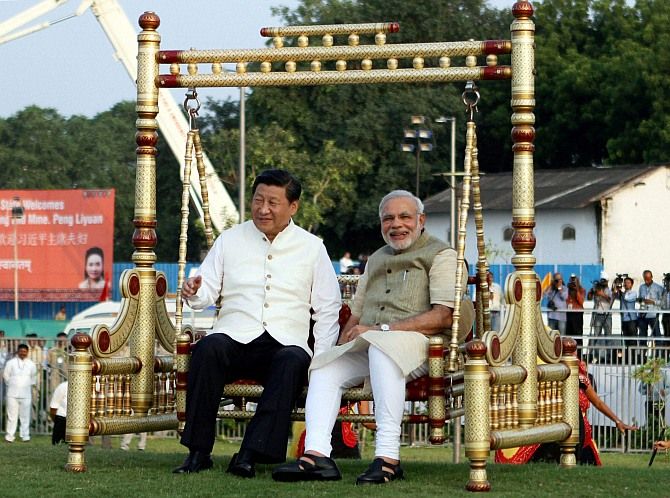
Photograph: Press Information Bureau
Analysed clinically, Modi's imaginative forays in diplomacy and strategic planning have been bearing fruit.
Take, for example, his diplomatic strike in relation to Balochistan.
It was taken after careful thought and a lot of groundwork and planning by his National Security Adviser Ajit Doval.
As it turned out, the move not only left Pakistan dumbstruck, but has also baffled China.
The reason: It is directed as much against Pakistan as against China in the context of the 3,000 km-long economic corridor that China is building from the Gwadar port on the Makran coast in Balochistan to Xinjiang province in China and the mining activities (including gold mining) of the Communist nation in Balochistan.
Gwadar is virtually developing into a Chinese base that can be used to monitor the activities of India, as well as US movements in the Middle East.
Any military build-up at Gwadar affects India because of its closeness to India's land as well as sea borders.
By the land route, Gwadar is less than 900 km from Jaisalmer.
By the sea route, it is equally close to Jamnagar, which has crucial Indian oil refinery installations and one of its foremost air force bases.
Gwadar's importance for China's economic interests can be figured out by considering the trading distance it will lessen for China in purely logistical terms.
The distance from Gwadar to Beijing is 12,000 km via the South-East Asia corridor and also involves travel by sea.
The distance between the same two destinations via Xinjiang is less than 6,000 km and that too by only road and rail.
Moreover, the distance from Gwadar to the China border is just 1,800 km by road.
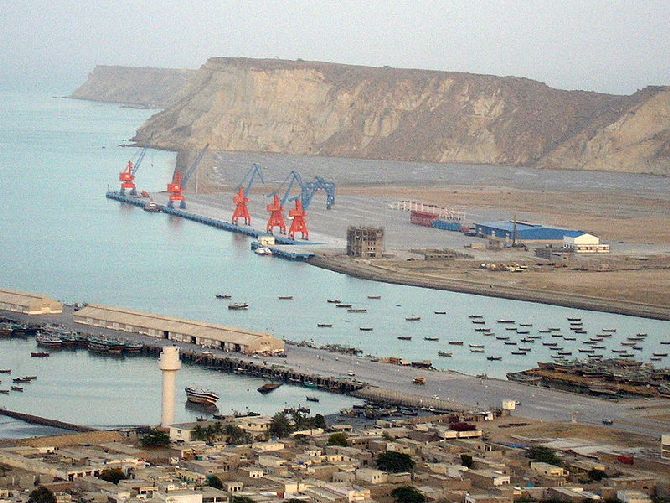
According to Baloch freedom activists, China has been mining over 15 kg of gold a day in Balochistan for three decades and that China is as responsible as Pakistan for the helpless situation of the Balochis.
China sees Gwadar as an answer to its 'Malacca riddle' -- which represents fear on its part that the US or any other rival power could hold the Chinese economy hostage by blocking the narrow straits of Malacca, through which its major goods traffic passes right now.
To counter China's Gwadar move, Modi has signed a deal with Iran to develop the Chabahar port there, which is just 100 km from Gwadar on the same coastline.
It is aimed at ensuring easier Indian trade with Afghanistan and the nations of Central Asia by road, apart from countering China and Pakistan.
The Chabahar port proposal was developed when the Atal Bihari Vajpayee government was in power.
Due to American sanctions against Iran and other factors, the proposal was on the verge of dying before Modi revived it. The Afghan border from Chabahar is about 1,300 km.
With India's rivalry with Pakistan and China assuming a sharp edge and Modi emerging as the new saviour of the Balochi people, the Chabahar port proposal has assumed a greater significance than ever before.
However, it has limited use against China and Pakistan considering the fact that it is a smaller port than Gwadar in terms of draught, and unlike Gwadar, where China will also anchor its warships, Chabahar holds the prospect of purely commercial use for India.
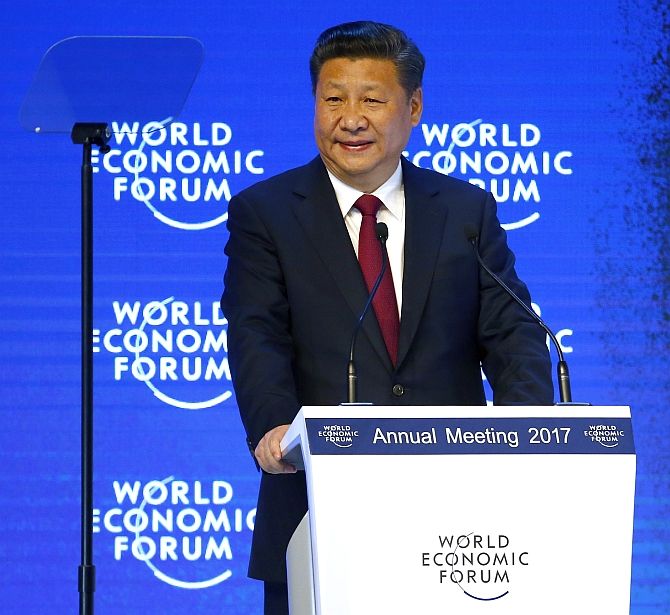
Xi was the first Chinese president to address a session at Davos.
Photograph: Ruben Sprich/Reuters
The punch in Modi's moves to counteract China comes from a deep understanding of the Chinese situation and an unstinted belief in the destiny of India based on the loftiness of its aims. Modi understands that China's rise was due to both military and economic growth made possible by an autocratic one-party rule.
But its economy, though still strong, is beginning to wane.
He also sees a flaw in the Chinese belief that its military and economic superiority will force everyone to accept it as a great power, over-riding the fact that it lacks a culture of accepting and managing contradictions in a spirit of give-and-take, and is prone to bulldozing others in a fast-changing world where freedom has a new meaning.
Cracks have started appearing in the Chinese economy. Though India stands nowhere near China in terms of exports and GDP, it outpaced China in FDI in 2016 -- the first country to do so in several years.
India got $63 billion in FDI while China got $56 billion in 2016.
China's exports have also started dropping and its currency was at a six-year low at the end of 2016.
China's GDP growth was also slower than that of India during this period.
On the employment front, China has started losing its workforce superiority.
China's population control measures in the form of the one child norm have had multiple effects.
The rule helped China check its population, but has also led to its workforce becoming costlier and not easily available.
The labour problems have even led to some Chinese companies moving out of the country. So the demographic advantage is shifting towards India.
Yes, the trade deficit between China and India remains huge due to China's advantage, but Modi knows that if India needs Chinese investments, China also needs markets to sell its goods and sustain itself at a time when its economy is shrinking.
There is no bigger market than India.
What is more, blessed with sound traits of detached observation, precise analysis and interpretation, Modi comprehends that China has aligned with forces that are on the wrong side of history.
These forces are dangerous and irresponsible nations like Pakistan and North Korea, which use terror and strong-arm tactics to make their presence felt.
Despite its tough exterior, China might be getting itself into a swamp, from which it might it find hard to emerge without losing face.
This situation might seem hypothetical at the moment given China's fearful might, but can't be ruled out as a future possibility.
Besides, how far can China manage the contradictions wherein it supports Pakistan's ultra-Wahhabi terrorists for its strategic objectives but cracks down ruthlessly not just on its own Wahhabi terrorists but also on common Muslims in the province of Xinjiang located on the border of Pakistan occupied Kashmir?
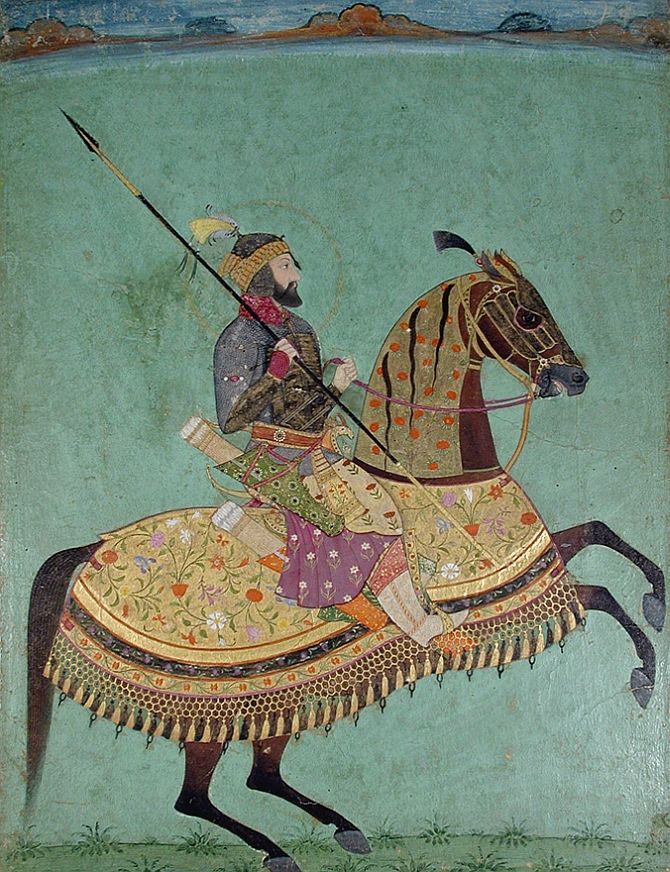
History shows that the fortunes of mighty empires and superpowers have often changed dramatically in a short span of time.
The Mughal empire seemed to be at the height of its glory when Aurangzeb ascended the throne in 1659, but had lost all its power within just ten years of Aurangzeb's death in 1707.
In south India, the Vijaynagar empire seemed to be at its zenith for a long time, having withstood Muslim invasions from the north for over two centuries. But it was all gone in 1565 in the battle of Talikota.
This happened within just 35 years of the departure of Krishnadevaraya, Vijaynagar's most powerful emperor.
Krishnadevaraya had never lost a battle against his powerful Muslim rivals and expanded the empire in all directions with his prowess.
In China's case, the one-party rule has started to elicit hush-hush reactions from the Chinese in a world that yearns for more and more freedom.
Some of these reactions are in the open, like when some groups in Hong Kong openly called for freedom in October-November 2016.
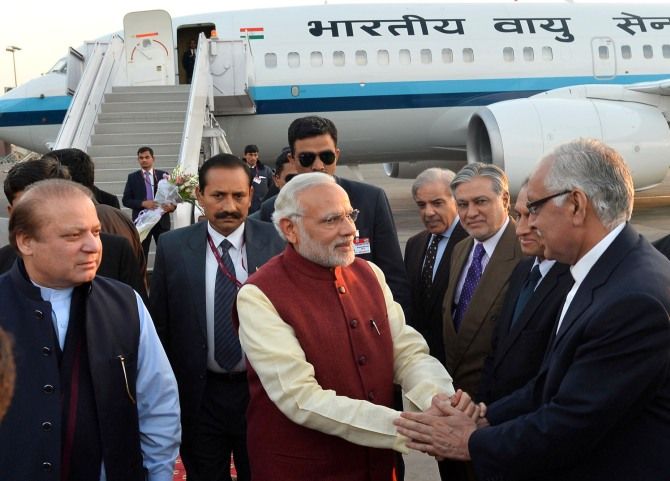
Both China and Pakistan failed to read the shrewd Modi correctly.
Modi tried to begin his innings as prime minister on a positive note with both China and Pakistan, perhaps due to his respect for India's image as an honourable, straightforward nation and his own strategic prerogatives.
He invited all SAARC nation heads, including Pakistan's Nawaz Sharif, for his swearing-in ceremony in 2014, and held a small summit with Sharif on the next day.
Later, in 2015, Modi made an unscheduled stop in Lahore to attend a function in Nawaz Sharif's family.
He had also invited Xi Jinping to India and hosted him in his home state, Gujarat.
Both Pakistan and China didn't get Modi's welcome signal right.
Perhaps they saw it as a sign of India's weakness, looking at it through the prism of the Nehruvian era.
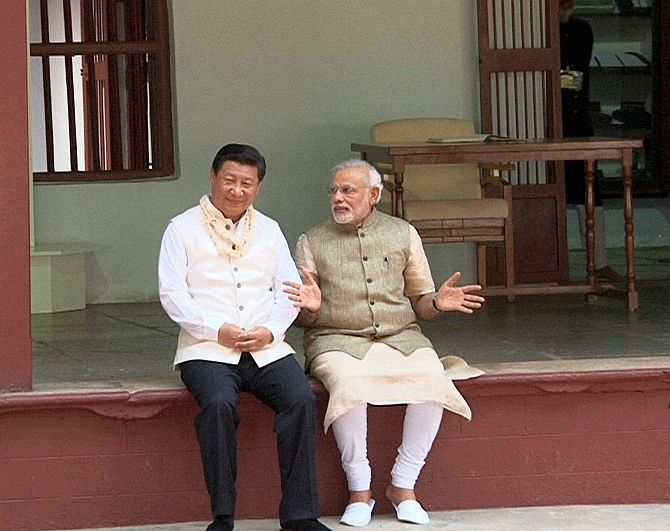
When the Modi-Jinping engagement was on in India, China practised its old policy of letting Chinese troops enter India's north-eastern border.
China was doing what it has done many times in the past at the time of any high-level Indo-Chinese dialogue -- planning an incursion into Indian borders to create pressure on India during negotiations.
Pakistan also continued with its old policy of stabbing India in the back when its troops attacked the Pathankot airbase within a week of Modi's unscheduled and extremely warm Pakistan visit.
But both the nations had calculated wrongly.
Modi is no Jawaharlal Nehru, who allowed China to get a seat in the UN Security Council in the 1950s despite China's aggression in Tibet.
Modi is a hardened politician with a strategic view on geopolitics.
Xi Jinping got a dose of Modi's medicine inside the very tent where he was being hosted on the banks of the Sabarmati river in Ahmedabad.
Modi reportedly told him, looking deep into his eyes: "This was not expected of your country. Can you tell me when the troops are withdrawing?"
Xi gave a deadline of a week and the troops withdrew after a few days.
China got more doses of the same pill when, immediately after this episode, Modi and US President Obama issued a joint statement expressing their concern over the rising tensions due to maritime territorial disputes in the South China Sea while affirming the importance of maritime security and freedom of navigation in the region.
The South China Sea is a crucial issue for China, which wants to maintain its military hegemony in the region. Nations like Vietnam and Japan are objecting to this.

The roadmap for Modi's global initiatives was prepared by Foreign Secretary S Jaishankar, with the national security focus coming from Ajit Doval in the case of countries in India's immediate neighbourhood, particularly Pakistan.
Jaishankar's worth lay in quickly grasping Modi's global vision while dealing with different nations and then preparing the roadmap accordingly -- not an easy job considering the fact that Modi thinks ahead of most others and very deep.
Jaishankar has boosted the policy planning and research division of the ministry of external affairs in such a way that crucial inputs while planning a Modi foreign trip are a click away.
Obviously, inputs based on deep research have played a big role in Modi's successful foreign visits.
One of the greatest achievements of these carefully crafted visits is securing FDI for India with inputs from the commerce and finance ministries.
In the countries that matter, Modi has gone the extra mile to woo local business groups to invest in India, his accompanying officers providing them useful inputs on how they could go about investing in India, with information on specific industries.
No wonder that India has emerged as the world's number one destination for FDI.
Ambassador to the US and China before becoming foreign secretary in 2015, Jaishankar was already well versed in cutting edge diplomacy.
He was a favourite of even the previous government which used his services as Indian ambassador to the US in laying the groundwork for the India-US nuclear deal under Manmohan Singh.
But with the arrival of Modi, Jaishankar's talent found a new and much better outlet capable of harnessing his capacity to the optimum level.
Excerpted from Marching with a Billion: Analysing Narendra Modi's Government at Midterm, by Uday Mahurkar, published by Penguin Random House, 2017, Rs 499, with the publisher's kind permission.

